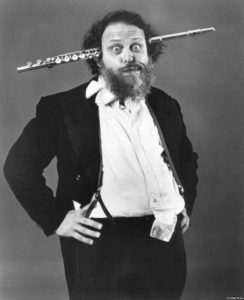It was a once-in-a-lifetime discovery. Like Howard Carter’s discovery of King Tut’s tomb in 1922 and Hiram Bingham’s discovery of the “lost” Incan citadel of Machu Picchu in Peru in 1911, Peter Schickele’s discovery of P.D.Q. Bach is the stuff of legend.

Here’s what happened.
It was 1953. Peter Schickele, born 1935, a “Very Full Professor” (a very young “very full” professor!) of “Music Pathology” at the University of Southern North Dakota at Hoople, was touring the “Lechendochschloss” in the German state of Bavaria. (For our information, we are told that the University of Southern North Dakota at Hoople “is a little-known institution which does not normally welcome out-of-state visitors.”)
Anyway, it was at the “Lechendochschloss” in Bavaria that the good professor discovered – “quite by chance, in all fairness” we are told – a music manuscript being used as a filter in the caretaker’s coffee maker. The music turned out to be the theretofore presumed lost “Sanka” Cantata, “the first autograph manuscript by P.D.Q. (‘Pretty Damned Quick’) Bach ever found.”
(Just as Johann Sebastian Bach’s contemporaries knew him as “Sebastian” Bach, and Carl Philipp Emanuel Bach’s contemporaries knew him as “Emanuel” Bach, so P.D.Q.’s contemporaries would have known him as “Quick” Bach.)
Little was known about P.D.Q. Bach’s music up to the time of Schickele’s discovery. He was born in Leipzig on April 1, 1742, to Johann Sebastian Bach (1685-1750) and Anna Magdalena Bach (née Wilcke, 1701-1760). He was Johann Sebastian Bach’s 21st and final child, according to Schickele, “the youngest and oddest of Johann Sebastian’s 20-odd children.” He died on May 5, 1807, although for reasons still unclear, the dates of his birth are often given in reverse in the literature as “1807-1742(?)”…
Continue reading, only on Patreon!
Become a Patron!